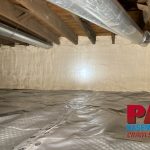A damp basement is more than just an inconvenience, it can lead to serious structural foundation issues, health risks, and costly repairs. The Windsor region has a unique climate and proximity to the Great Lakes that creates additional challenges for homeowners looking to keep their basements dry. This article explores the dangers posed by a leaky basement and offers practical tips to prevent moisture-related issues, ensuring the long-term health of your home and your family.
The Dangers of a Damp Basement
A damp basement can manifest in several ways, from a musty smell to visible water seepage. These seemingly minor issues can quickly escalate, leading to a range of wet basement repairs that affect both the home and its occupants. If you notice any of these signs, you should call a basement waterproofing specialist immediately before things get worse.
Below are some of the most significant risks associated with a damp basement or crawl space:
1. Structural Damage
Water infiltration can compromise the integrity of a home’s foundation. Over time, moisture and dampness can cause cracks in walls, floors, and ceilings, weakening the structural components of the building. If left unaddressed, this can lead to foundation shifting, uneven floors, pipe bursts and even the risk of a collapse in extreme cases.
2. Mold and Mildew Growth
Moist environments are common causes of wet basement issues, they are a breeding ground for mold and mildew. In humid summers, even a small amount of moisture can lead to rapid mold growth. Not only can this damage the materials in your basement, but mold can also spread to other parts of your home and insulation, posing significant health risks. Mold exposure can lead to respiratory issues, allergies, and, in severe cases, more serious conditions like asthma or lung infections.
3. Health Hazards
Beyond mold, damp basements can harbor bacteria, dust mites, and other allergens. Poor air quality in the basement can easily affect the entire home, particularly if the HVAC system pulls air from the basement and circulates it. This can exacerbate health conditions for anyone living in the home, particularly children, or the elderly, living with pre-existing respiratory issues like asthma.
4. Electrical and Fire Hazards
A damp basement can pose serious electrical hazards, especially if excess water reaches electrical outlets, wiring, or appliances stored in the basement area. Water is a conductor of electricity, and contact with damp or flooded areas can increase the risk of electrical shocks or even fire.
5. Decreased Property Value
Homes with a history of water damage or a persistent moisture problem in the basement can see a significant reduction in property value. Prospective buyers are wary of homes with unresolved damp issues due to the associated risks and the potential cost of repairs. You want to ensure you have a water-tight residence and no water can continue to enter your basement.

Understanding the Climate in Windsor-Essex County, Ontario
Windsor-Essex County is located on the southernmost part for all of Ontario, it experiences a climate characterized by warm, humid summers and cold, snowy winters. The city’s proximity to the Great Lakes results in increased precipitation, particularly during the spring and summer months, when heavy rainfall can lead to pooling and water entering around your basement’s foundation. Additionally, the freeze-thaw cycle in winter can cause cracks in foundation walls, creating entry points where water can enter. These environmental factors, combined with older houses settling in some areas, make Windsor homeowners particularly susceptible to wet basement problems.
Preventing a Damp Basement in Windsor
To prevent a damp basement, Windsor homeowners need to take proactive measures, particularly given the region’s weather patterns. Below are some effective strategies for keeping your basement dry and your home safe. In terms of our Basement Waterproofing service area, we cover all of Southwestern Ontario, from Sarnia-Lambton, to Chatham-Kent, and Windsor-Essex County.
1. Improve Drainage Around Your Home
One of the most important steps in keeping water out of your basement is to ensure proper drainage around your home. Gutters and downspouts should be regularly cleaned and extended at least six feet away from the foundation to divert water. Additionally, grading the landscape around your home so that groundwater slopes away from the foundation is critical in keeping moisture at bay.
2. Install a Sump Pump
A sump pump is a valuable investment for any home particularly those prone to home’s that have had a basement flooded in the past. A sump pump collects excess water in a pit and pumps it away from the house, preventing it from pooling and seeping into the basement. For additional peace of mind, consider installing a battery-powered backup sump pump or a water-driven pump in case of power outages during storms.
3. Seal Foundational Wall Cracks
Inspect your basement walls and floors regularly for cracks, which can serve as entry points for water. Call in a professional waterproofing company such as Paul’s Basement Waterproofing to patch wall cracks before they become larger issues. In some cases, structural foundation repair may be required for larger or more serious cracking, particularly if they are caused by shifting soils or structural issues.
4. Install a Basement Waterproofing System
For homes with chronic moisture problems, a full basement waterproofing system may be necessary. This typically involves the installation of interior or exterior drainage systems and waterproof membranes to prevent water from seeping through the walls or foundation floor. While this can be a significant upfront investment for waterproofing services, it provides long-term protection and peace of mind.
5. Use a Dehumidifier
During our more humid summer months, it is beneficial to run a dehumidifier in your basement to reduce moisture levels. Keeping humidity levels below 50% can prevent mold growth and keep the air in your basement fresh and dry. Health Canada recommends running a dehumidifier and keeping humidity levels between 30 and 50% in your basement to better protect your home from mold.
6. Ensure Proper Ventilation
Proper ventilation is crucial in maintaining a dry basement. This includes ensuring that vents and basement windows are functional and that airflow is not obstructed. Installing an exhaust fan can also help remove excess moisture from the air, particularly in finished basements.
Call Paul’s Basement Waterproofing Today!
Paul’s specializes in basement waterproofing and foundation repair. We offer comprehensive basement waterproofing solutions, including foundation crack repair, sump pump installation, and full foundation repair services tailored to your current situation. As always, we offer free inspections and consultations, allowing homeowners to assess their specific needs before committing to repairs or upgrades.

We understand the unique challenges homeowners face due to extreme weather, and our repair specialists are designed to prevent wet basement issues effectively. By investing in our highly experienced team, homeowners can protect their homes from water damage, ensuring long-lasting stability and safety.





